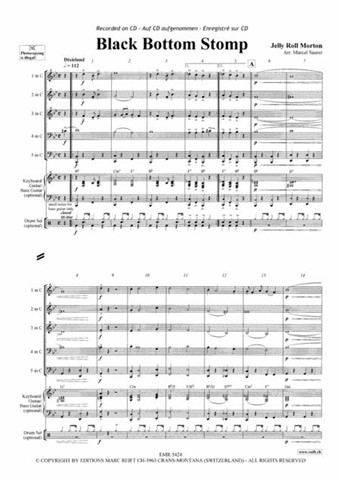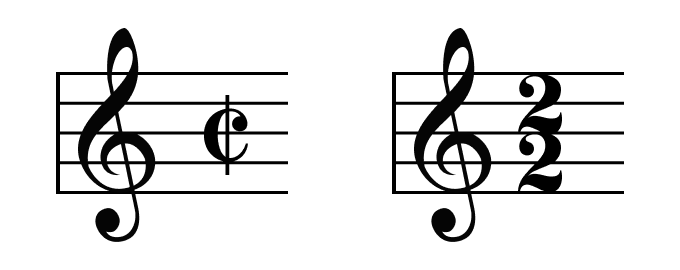
The Big Band Sound
One early example of the big-band sound is heard in Jelly Roll Morton's "Black Bottom Stomp" , recorded in 1926. By studying this song, we can ascertain the instruments commonly used in big-band music and to what effect as well as its similarities to and differences from swing music.
From [00:00-00:04], we hear a short A section, consisting of only four measures that repeat. The meter/time signature is cut time A tempo marking indicating a quick duple meter with the half note rather than the quarter note getting the beat (2/2 rather than 4/4). Both the name and the sign are a vestige of mensural notation and of the proportions (tempus imperfectum diminutum). or alla breve. In this meter, each measure happens in the span of two beats.
The melody in the clarinet allows a more detailed explanation as follows: Part A consists of two measures, as does A1. Both phrases fit perfectly in groups of two. The B section starts at (00:08-00:21) measure six. Its prime occurs on the downbeat of measure ten. This section functions much like the first. There is a clear distinction between the antecedent and consequent phrases. It also serves as a transition into another section that features solo improvisation (00:22-00:37). Such are the characteristics of big-band music. That is solo improvisation that is interspersed within the ensemble.
The term "big band" can be applied to any large jazz or dance orchestra, usually with a minimum of ten players and averaging fourteen. However, some larger ensembles have expanded to more than twice that number. The term has remained in use as the generic definition of a large jazz ensemble, but when it is applied to define the "Big Band Era," it carries a more specialized meaning and defines the period from the mid-1920s until the early 1940s that is also known as the "Swing Era." During these two decades, big bands were among the principal performers of popular music in the United States and Europe. There were widespread imitators in territories as diverse as the USSR and Argentina. By analyzing swing music, the predominant style of music played by big bands, we can better understand big-band jazz.
Don't Worry 'Bout Me
Don't worry 'bout me Forget about me
Just be happy my love
A-Tisket A-Tasket
A-tisket a-tasket
A green-and-yellow basket
I bought a basket for my mommie
On the way I dropped it







